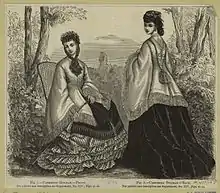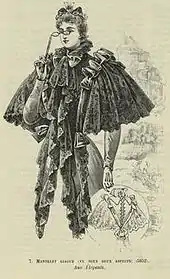
A mantle (from old French mantel, from mantellum, the Latin term for a cloak) is a type of loose garment usually worn over indoor clothing to serve the same purpose as an overcoat. Technically, the term describes a long, loose cape-like cloak worn from the 12th to the 16th century by both sexes, although by the 19th century, it was used to describe any loose-fitting, shaped outer garment similar to a cape.[1] For example, the dolman, a 19th-century cape-like woman's garment with partial sleeves is often described as a mantle.[2]
In English, the idiom "to take up/pick up/assume the mantle" is from the Bible, and means to take a position of authority, leadership or responsibility in a particular area, especially in the sense of carrying on for a previous figure.[3] The most notable appearance in the Bible is in 2 Kings 2:13, where Elisha takes up Elijah's mantle (Hebrew: אדרת ’addereṯ).
Mantelets

A variation on the mantle is the mantelet (also spelled mantelot and mantlet), typically describing a short version of the mantle. The term appears as early as 1386, in "The Knight's Tale" by Geoffrey Chaucer. In the 18th century, a mantelet was a woman's short cloak, and in the early 19th century, it was an ornamental scarf that crossed over the chest and tied behind, usually made of fur or lace.[1] By the end of the 19th century, a mantelet was a woman's shoulder cape with elongated ends in front, sometimes held in position by a belt at the waist.[1]
See also
References
- 1 2 3 Calasibetta, Charlotte Mankey (1988). Fairchild's Dictionary of Fashion (2nd ed.). New York: Fairchild Publications. pp. 363–64. ISBN 1-56367-235-9.
- ↑ Calasibetta, Charlotte Mankey (1988). Fairchild's Dictionary of Fashion (2nd ed.). New York: Fairchild Publications. p. 166. ISBN 1-56367-235-9.
- ↑ "What Does Take Up the Mantle Mean?". Writing Explained. Retrieved December 12, 2018.